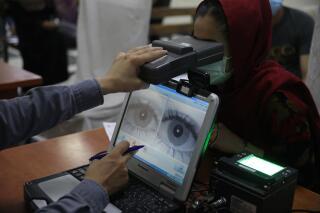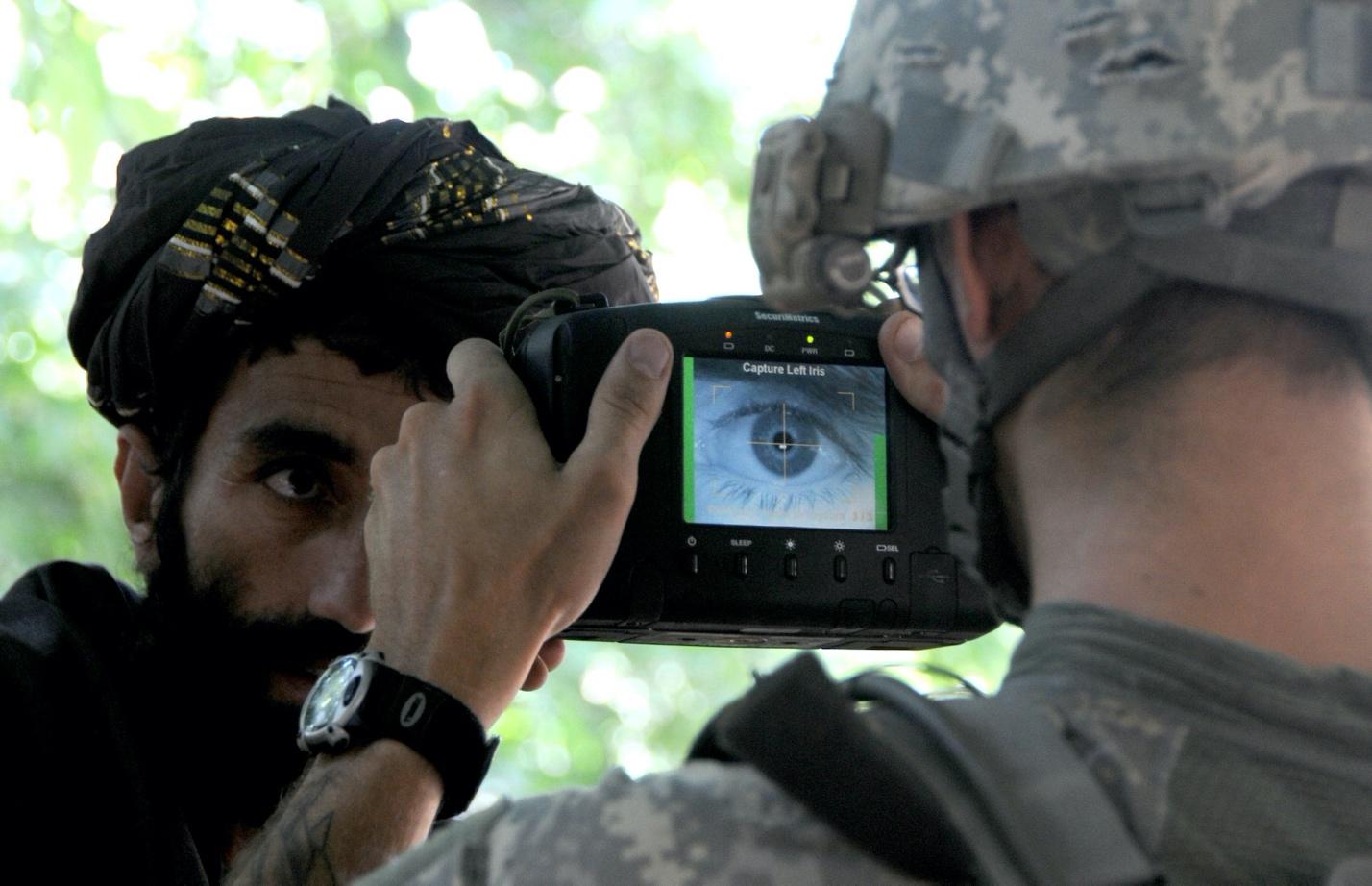
Over the two-decade U.S.-NATO military occupation of Afghanistan, the U.S. and its allies spent hundreds of millions of dollars building digital databases of the Afghan people that were used for surveillance and political repression.
According to a September 2021 article by Associated Press technology reporter Frank Bajak, which was based on a U.S. Special Inspector General for Afghan Reconstruction report, the digital database included biometrics for verifying Afghan identities and was used to manage Afghan army and police payrolls.[1]
Bajak wrote, in addition, that the database included birth dates, phone numbers, and the father’s and grandfathers’ names of more than 700,000 security force members going back 40 years, and could query fingerprints and iris and face scans stored in a different database with which it was integrated.
Originally conceived to fight payroll fraud, the database system was supposed to interface with a database at the Defense and Interior Ministries modeled on one the Pentagon created in 2004 to achieve “identity dominance” by collecting fingerprints and iris and face scans in combat areas.
The homegrown Afghan Automated Biometrics Information System came to contain 8.5 million records, including personal data on government foes and the civilian population. The data were used to issue biometrically backed identification cards to 1.65 million Afghans for purposes of population control.
Identity cards had similarly been issued to South Vietnamese residents during the Vietnam War, who had to show their cards at police checkpoints to prove that they were not affiliated with the Vietcong. In the Afghan case, it was the Taliban.[2]
Wired magazine journalist Noah Shachtman wrote that the biometric identity card system in Afghanistan was “a high-tech upgrade to a classic counterinsurgency move—simultaneously taking a census of the population, culling security forces of double agents and cutting off guerrilla routes. (Plus, bombs and weapons can be swabbed for fingerprints to build files on insurgent suspects.)”
NATO Training Mission-Afghanistan Commander Lt. Gen. William Caldwell noted that “the system allows the Afghans to thoroughly screen applicants and recruits [to the army and police] for any potential negative past history or criminal linkages, while at the same time it provides an additional measure of security at checkpoints and major facilities to prevent possible entrance and access by malign actors in Afghanistan.”
While sounding good on paper, the system was not fool-proof, as insurgents passed the screening and green-on-blue incidents where Afghans security force or army officers killed their own advisers or commanders reached record levels.
When Kabul fell, the Pentagon’s biometric identification database was being upgraded, along with a similar database in Iraq, under a $75 million contract signed in 2018.
In both cases, technological sophistication could not offset the U.S. political weakness—and, hence, did not lead to any heroic victories.

Hamiltons and PROMIS
Bill Hamilton is a retired National Security Agency (NSA) employee who translated North Vietnamese newspapers for the CIA during the Vietnam War.
In an exclusive interview with CovertAction Magazine, he said he believes that the Afghan digital database and surveillance system was likely developed from computer software that he and his wife Nancy developed in the 1970s and the CIA stole from them.
Hamilton said that the computer system for tracking Afghans “smells like PROMIS,” noting that the U.S. government “does this not just in Afghanistan but all around the world.”

PROMIS stands for Prosecutors Management Information System. It was originally created by the Hamiltons’ company, called the Institute for Law and Social Research (INSLAW), to help law enforcement agencies track court cases and criminal offenders and was adopted by state and local prosecutors’ offices, including in cities like New York and Los Angeles.
In the mid-1970s, INSLAW was awarded a $10 million contract to install the PROMIS software in 94 Department of Justice offices before it was forced into bankruptcy and taken over by officials in the Justice Department working under Edwin Meese, Ronald Reagan’s Attorney General.
Hamilton believes that INSLAW was used by banks to enable NSA and the CIA to track wire transfers of money and letters of credit, and by the CIA to track dissidents and alleged troublemakers in an emergency preparedness program commissioned by the Federal Emergency Management Agency (FEMA).
Then-CIA Director William Casey was the driving force for most of the unauthorized, copyright-infringing uses of INSLAW’s PROMIS, which was carried out by the CIA’s Division-D.


The PROMIS software was so valuable because it enabled collection of a vast amount of personal data on Americans, including NSA intercepts of bank and credit card transactions and the results of surveillance efforts by the FBI, CIA and other agencies.
Lockheed Martin engineers also got a hold of PROMIS and developed sophisticated software for the cockpits of some of its planes, like the F-117 stealth fighter which is invisible to radar.
Throughout the mid to late 1980s, the PROMIS software was sold to intelligence services worldwide by Dr. Earl W. Brian, a veteran of the Phoenix Program in Vietnam and former director of California’s Department of Health Care Services, with close connections to Meese.

Dr. Brian’s holding company, Biotech Capital Corporation, had 40 computer system contracts with U.S. intelligence agencies, and tried to pressure Hamilton into selling INSLAW.
According to various sources, Brian was involved in the “October Surprise” where the Reagan campaign paid the Iranians to delay the release of American hostages during the 1980 election to make incumbent Jimmy Carter look bad and help Reagan win the White House.
CIA whistleblower Michael Riconosciuto claimed that PROMIS software was Brian’s payment for participation in the “October Surprise” and other covert operations.
Riconosciuto told Unsolved Mysteries that Dr. Brian and other men involved in the PROMIS theft participated in the Iran-Contra affair and covert operations in Central America and the Middle East that involved illegal drugs and arms smuggling.
Dr. Brian and Peter Videnieks of the Justice Department supervised a joint venture of the Cabazon Band of Cahuilla Indians in Indio, California, and Wackenhut, the nation’s third-largest private security firm, of which Riconosciuto was the research director, to copy and modify the PROMIS software for spying purposes.
Part of Riconosciuto’s job in the modification of the software was to create “back door access” for spying into the files of its users which included Great Britain, South Korea, Japan, Jordan, Canada, Israel, Egypt, Canada and Iraq.
Brian’s customers for the revamped spy software included the Israelis, who used PROMIS to track “troublesome” Palestinians, according to Rafi Eitan, long-time deputy director of Mossad’s covert operations, who gushed: “We can use that program [PROMIS] to stamp out terrorism by keeping track of everyone. But not only that, we can find out what our enemies know too.”


These comments make clear the motive underlying the use of the PROMIS software to establish a vast social control apparatus in Afghanistan that could help serve U.S. imperial ambitions.
Those ambitions could never be fulfilled because the Afghan government lacked legitimacy and drove Afghans into the arms of the Taliban, including by terrorizing the civilian population in military and police sweeps that made use of information derived from the digital database.

Bajak expressed concern in his article that, after their takeover, the Taliban were poised to deploy the U.S. digital database as a tool of repression, “the high tech jackboot of a surveillance state.”[3] He quoted from a Brooklyn Law School scholar of surveillance, Frank Pasquale,[4] who said “it’s a real object lesson in ‘the road to hell is paved with good intentions.’”
But the intentions were never good, as the U.S. government had imported stolen CIA software in Afghanistan to establish an Orwellian social control apparatus that fueled vast human rights abuses by a corrupt, quisling government which discredited itself in the eyes of its own people.
And, like previous empires, the U.S. had invaded Afghanistan illegally and under fraudulent pretexts in order to steal its resources and use it as a base to project U.S. power into Central Asia, a region considered crucial for global domination.

Bajak’s article was published several days after the completion of the unexplained precipitous withdrawal of U.S. Armed Forces from Afghanistan. ↑
On Vietnam-era identity card programs and how they fit into larger counterinsurgency operations, see Jeremy Kuzmarov, Modernizing Repression: Police Training and Nation Building in the American Century (Amherst, MA: University of Massachusetts Press, 2012), ch. 7. ↑
In an email correspondence on March 8 2024,, Hamilton raised the question with me as to whether the Taliban, in acquiring control of the PROMIS software, acquired evidence of the personal financial gain of U.S. politicians from the sale and distribution of unauthorized, copyright-infringing derivatives of INSLAW’s PROMIS in support of the U.S. War in Afghanistan. ↑
Pasquale is now a professor at Cornell. ↑
CovertAction Magazine is made possible by subscriptions, orders and donations from readers like you.
Blow the Whistle on U.S. Imperialism
Click the whistle and donate
When you donate to CovertAction Magazine, you are supporting investigative journalism. Your contributions go directly to supporting the development, production, editing, and dissemination of the Magazine.
CovertAction Magazine does not receive corporate or government sponsorship. Yet, we hold a steadfast commitment to providing compensation for writers, editorial and technical support. Your support helps facilitate this compensation as well as increase the caliber of this work.
Please make a donation by clicking on the donate logo above and enter the amount and your credit or debit card information.
CovertAction Institute, Inc. (CAI) is a 501(c)(3) non-profit organization and your gift is tax-deductible for federal income purposes. CAI’s tax-exempt ID number is 87-2461683.
We sincerely thank you for your support.
Disclaimer: The contents of this article are the sole responsibility of the author(s). CovertAction Institute, Inc. (CAI), including its Board of Directors (BD), Editorial Board (EB), Advisory Board (AB), staff, volunteers and its projects (including CovertAction Magazine) are not responsible for any inaccurate or incorrect statement in this article. This article also does not necessarily represent the views the BD, the EB, the AB, staff, volunteers, or any members of its projects.
Differing viewpoints: CAM publishes articles with differing viewpoints in an effort to nurture vibrant debate and thoughtful critical analysis. Feel free to comment on the articles in the comment section and/or send your letters to the Editors, which we will publish in the Letters column.
Copyrighted Material: This web site may contain copyrighted material the use of which has not always been specifically authorized by the copyright owner. As a not-for-profit charitable organization incorporated in the State of New York, we are making such material available in an effort to advance the understanding of humanity’s problems and hopefully to help find solutions for those problems. We believe this constitutes a ‘fair use’ of any such copyrighted material as provided for in section 107 of the US Copyright Law. You can read more about ‘fair use’ and US Copyright Law at the Legal Information Institute of Cornell Law School.
Republishing: CovertAction Magazine (CAM) grants permission to cross-post CAM articles on not-for-profit community internet sites as long as the source is acknowledged together with a hyperlink to the original CovertAction Magazine article. Also, kindly let us know at info@CovertActionMagazine.com. For publication of CAM articles in print or other forms including commercial internet sites, contact: info@CovertActionMagazine.com.
By using this site, you agree to these terms above.
About the Author

Jeremy Kuzmarov holds a Ph.D. in American history from Brandeis University and has taught at numerous colleges across the United States. He is regularly sought out as an expert on U.S. history and politics for radio and TV programs and co-hosts a radio show on New York Public Radio and on Progressive Radio News Network called “Uncontrolled Opposition.”
He is Managing Editor of CovertAction Magazine and is the author of six books on U.S. foreign policy, including Obama’s Unending Wars (Clarity Press, 2019), The Russians Are Coming, Again, with John Marciano (Monthly Review Press, 2018), Warmonger. How Clinton’s Malign Foreign Policy Launched the U.S. Trajectory From Bush II to Biden (Clarity Press, 2023); and with Dan Kovalik, Syria: Anatomy of Regime Change (Baraka Books, 2025).
Besides these books, Kuzmarov has published hundreds of articles and contributed to numerous edited volumes, including one in the prestigious Oxford History of Counterinsurgency .
He can be reached at jkuzmarov2@gmail.com and found on substack here.



